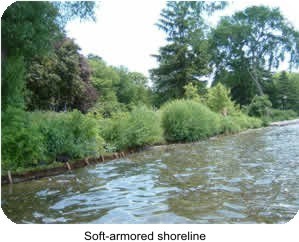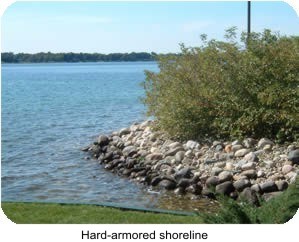Erosion Control
This page summarizes the wide variety of methods available to stabilize shorelines without installing a vertical sea wall. Sea walls interrupt the natural transition from land to water. They disrupt habitats and disperse wave energy to neighboring properties. Alternative shoreline management offers alternatives to vertical sea walls.
 Soil Bioengineering
Soil Bioengineering
There are two types of bioengineering techniques available in lakescaping: soft-armor and hard-armor. Soft-armor bioengineering implies the use of live vegetation, whereas hard-armor requires the use of rocks, concrete or metal.
Soft-armor bioengineering – The placement of plant materials into structures that are designed to withstand wave and ice action. Soft-armor bioengineering is appropriate anywhere there are suitable conditions for plants to grow. This means adequate soil, sunlight and water. As the plants grow, their root structures naturally stabilize the shoreline.
Rock Riprap – A very common hard-armor technique which consists of large rocks placed in the water and up the slope along the shoreline. Riprap should be lined with geotextile fabric to prevent wave action from sucking soils from behind rocks, causing slumpage. Joint planting involves planting between rocks for a softer look and greater stability.
Erosion Control Fabrics – Erosion control blankets such as jute, coir (coconut husk fiber) and wood-fiber blankets are useful on slopes for holding  the soil in place until plants establish from seed. These products are staked over a seeded area and allow plants to grow through the fibers. Plug plantings can be planted through the open woven fabrics or through slits made in the fabric of denser products. Geotextile fabrics are made of densely woven material that can withstand instense wave energy when placed under rock rip-rap.
the soil in place until plants establish from seed. These products are staked over a seeded area and allow plants to grow through the fibers. Plug plantings can be planted through the open woven fabrics or through slits made in the fabric of denser products. Geotextile fabrics are made of densely woven material that can withstand instense wave energy when placed under rock rip-rap.
Soil bioengineering may be used on stream banks and shorelines. Most Michigan projects require a permit.
For detailed information on soil bioengineering techniques, please see the Natural Resources Conservation Service’s (NRCS) Engineering Handbook chapter on Streambank and Shoreline Protection (7.79 MB pdf).
For a listing of plant materials suitable for soil bioengineering, please see the USDA/NRCS Plant Materials Technical Note – No. 1 (pdf).